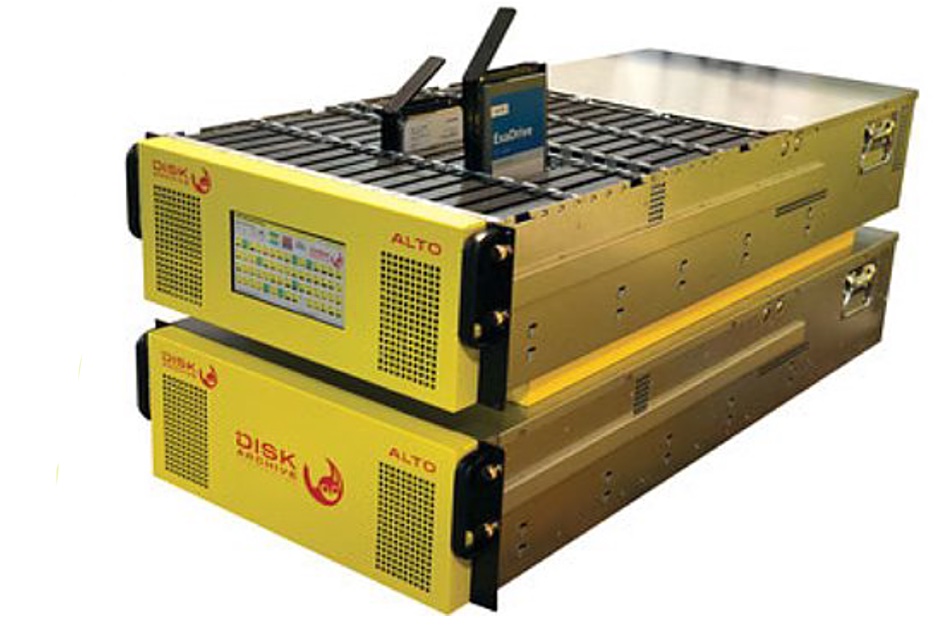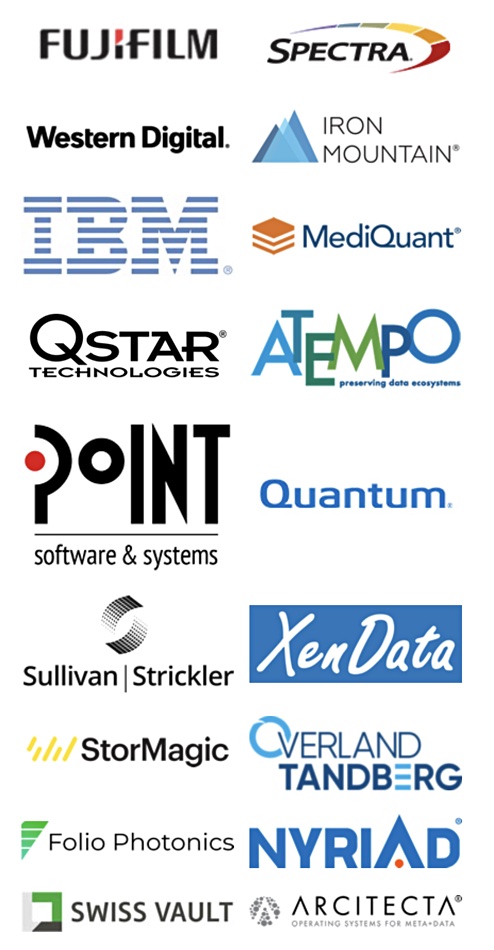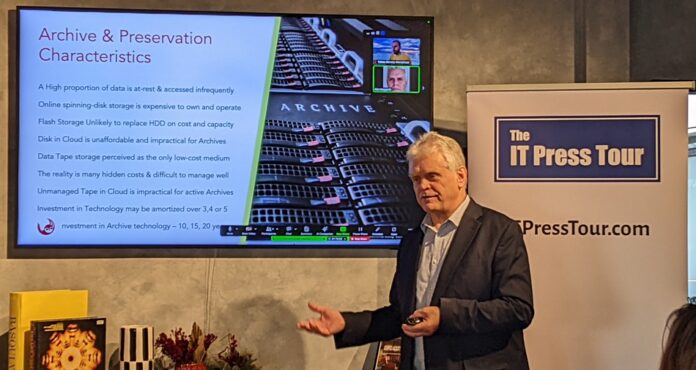UK-based Disk Archive Corporation, known for its spun-down disk archives, says it now has 350 broadcast and media company customers. Its pitch is that its performance can beat both tape and optical disk archives.
The company was founded in 2008 and developed and sells its ALTO appliance, ALTO standing for Alternative to LTO, a 60-disk drive 4RU chassis and embedded server, with up to 10x 60 HDD expansion chassis for a total raw capacity of 660 x 24 TB HDDs = 15.8 PB. The system can scale out to over 200 PB, and if 26 TB SMR drives are used, the capacity will be even higher.
Alan Hoggarth, CEO and co-founder, briefed an IT Press Tour in Madrid, and talked about the company’s beginnings. “We wanted to break the mold – transcending traditional data tape, video tape, optical disk, and cloud solutions. A large broadcaster could have a million video tapes. Bypass them and stick them on disk,” he said.

His thinking was that Copan’s original MAID (Massive Array of Idle Disks) concept was flawed. This was a disk-based archive that delivered faster access to data than tape archives, and saved on energy costs by spinning down the drives until their content was needed. But it used RAID sets so several drives had to be spun up when data was required, and data could conceivably be lost, Hoggarth said. A v2 MAID based on slowed-down but not spun-down drives wouldn’t deliver the power savings and environmental benefits of fully spun-down drives. However, if you didn’t use RAID sets and fully spun down the disks, a disk archive could provide a lower TCO than a tape archive because there is no need for tape generation migrations or robotic libraries, saving energy and cooling costs.
A tape library needs robotics to bring cartridges to the read/write drives. But a disk archive has no need for robots because each disk is a drive as well.
An optical disk archive is subject to the whims and happenstance events of the restricted set of suppliers, such as Sony closing down optical disk product lines. Similarly, the tape market can be upset by disputes between the duopoly suppliers Sony and FujiFilm, as happened in 2019 with LTO-8 media supply seriously disrupted.
The ALTO active archive system was designed specifically for film production, TV broadcast, and legal evidence (court recording) markets where video and audio assets have to be kept for decades with faster-than-tape access to files when required. It relies on SATA disk drives, which do not suffer from generational media access problems that affect both tape and optical disk. The affordable SATA interface is used because faster SAS or even NVMe access is not needed in the archive access situation. When it takes 60 seconds to spin up a quiescent drive, having a faster interface in the milliseconds area is simply not relevant.
The disk drives in an ALTO system may only spin for 50 hours a year. This vastly reduced active period extends their usable life out to 15 years or longer. Hoggarth noted that helium-filled drives prevent disk motor and spindle lubricant evaporating, which did occur with some air-filled drives.
ALTO is sold as an unpopulated chassis, with customers buying their own disk drives. Hoggarth said: “Data reduction is not feasible with video and audio images. We talk raw data.”
It writes raw data files to a pair of disk drives, and drives can be removed for storage on a shelf on-premises or in an external vault. That means if Disk Archive Corporation goes bust, customers can still read the data from the disk drives. It also provides a physical air-gap, preventing ransomware access.
Hoggarth told B&F: “We write two copies to two identical disks. There is no RAID controller so they’re not mirrored. One disk stays on the appliance. The other is put on the shelf and the pair put in read-only mode.” A person takes out the second drive in a pair, puts a generated QR code on it, then moves it to a shelf location.
Every disk drive has a UUID, a Universal Unique Identifier, and the ALTO software knows and tracks this. The QR code label includes the UUID and the ALTO system tracks QR codes, UUIDs, and shelf locations to know which files/folders are on which disks and where. A management system has a GUI facilitating this.
Alternatively, both disks could stay in the appliance, providing a media-redundant archive. You could make it more resilient against failures with a media-redundant high-availability archive by putting the second disk drive in a pair in a separate chassis.
ALTO systems need active human admins because they have no robotics, unlike tape libraries. Hoggarth said robotics and tape suffer from humidity, needing air conditioning, and have difficulties in humid environments such as in Asia. Disk Archive Corporation’s first customers were in Asia and its no-robotics feature has proved a strong advantage when selling in tropical environments.
Virtually every country has a state or private TV broadcaster and film company, also a legal system, and they will all need video/audio archives. The no-robotics characteristic gave Hoggarth’s company a real edge when selling into tropical countries.
The system’s electricity consumption is low, even with a management system running in a server. Hoggarth said: “We keep a flat file record of everything stored in an server, which adds background power consumption.” The power consumption of an ALTO disk archive system is 210 watts/PB with 22-24 TB disks. As disk capacities rise, the watts/PB number goes down.

According to Oracle documentation: “A ten module library with 20 tape drives and 20 power supplies has a total idle power of 338 W (1154 Btu/hr) and a steady state maximum of 751 W (2564 Btu/hr).” The ALTO spun-down disk archive library has lower power consumption than this.
The ALTO system can support a third copy of a disk stored in the cloud as a last resort. The Disk Archive Corporation website has various case studies illustrating different ALTO configurations. There is a reduced depth or short-rack alternative for space-restricted datacenters.
The Active Archive Alliance trade association was set up to advance the idea of an active archive, one with a higher than normal archive data access rate. It is a vendor-neutral forum with members such as FujiFilm, Quantum, SpectraLogic, and others. Curiously, Disk Archive Corporation is not a member, having never seen the need in its clearly defined market niche.
The company has just 15 employees in the UK, Italy, and India. The biggest worldwide market is India by a wide margin. It was Russia but then “bad things happened,” Hoggarth said.
Amazingly, the company owns no IP. Everything is open. The mainstream archive companies ignore this market for spun-down disks. Hoggarth says many of them sell tapes and tape systems and make a lot of money from them. “They have no incentive to change.”
There are around 450 Disk Archive customers and the company is involved in a 100 PB archive project. The rough price range for an ALTO head unit is $24,000-$40,000, depending on features.
In these steadily greening days, the idea of a cheaper and faster-than-tape archive with more longevity that better satisfies environmental, social, and corporate governance criteria could look an attractive proposition.








